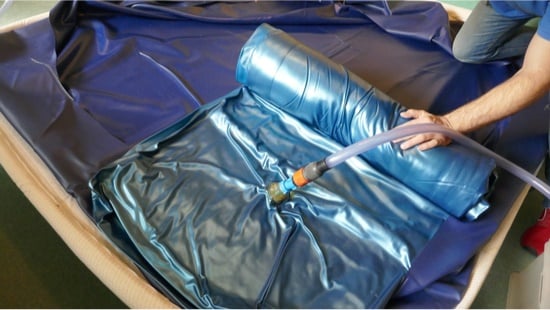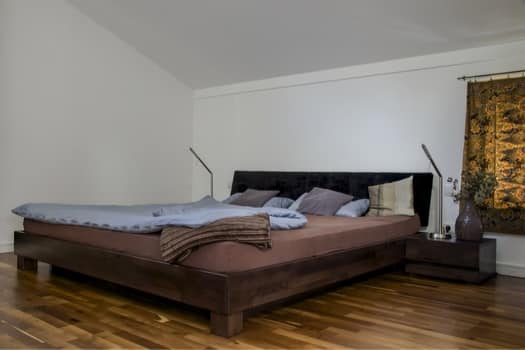Bed bugs live in beds, hence how they got their name. But bed bugs dislike water and can’t swim. So, you could be forgiven for thinking that the water in a waterbed would keep bed bugs away.
Bed bugs can live in cracks in the bed frame, and around the outside. From these hiding places, they will have easy access to a host and feed on you during the night. However, they can’t live inside a waterbed. Bed bugs can’t burrow into things, so they live on the surface instead.
Waterbeds are more difficult to treat for bed bugs than normal mattresses because they’re so heavy. We address how to get bed bugs out of waterbeds, why they’re attracted to them, and more.
Can Bed Bugs Live in Waterbeds?
Bed bugs can live in any bed. They prefer the bed frame and mattress over any other home. That’s because it’s close to you while you sleep, which gives them a chance to feed.
The bed frame and mattress also offer hiding places. There are lots of cracks, joins and hidden parts in a bed frame. Here, they can’t be disturbed. And mattresses offer folds, seams, buttons and zips for them to hide under too.
Can Bed Bugs Live Inside Waterbeds?
Bed bugs don’t live inside mattresses, unless there’s a hole for them to get into. They can’t burrow because they don’t have strong jaws like other bugs. Instead, they live on the outside of mattresses.
The first places they will search for are folds. Fabric piping around the edge of a mattress gives them a secure place both to hide, and to lay eggs.
If there’s a hole in the mattress, they will spread to it. However, they likely won’t spread through the mattress. If they did, it would be too difficult for them to find their way in and out.
This is a relief if you have a waterbed, because if they did burrow, you might have a leak.
Are Bed Bugs Attracted to Waterbeds?
A waterbed can be a big, expensive purchase. It would be a shame to find out that bed bugs are attracted to them. Bed bugs and waterbeds would be a frustrating combination.
Unfortunately, they are. Let’s take a look at what it is about waterbeds that attract them, and whether they’re worse for bed bugs than normal mattresses.
Standard Waterbeds
Bed bugs are attracted to three things: heat, carbon dioxide, and the smell of people. They use these signs to tell where their host is, so they can easily feed.
As such, bed bugs are attracted to waterbeds. The bedding on them will smell like you, for a start. And when you’re asleep at night, you give off warmth and carbon dioxide.
The bugs will be attracted to the bed frame and the mattress itself. They prefer locations that are closed off, dark, and rarely disturbed. Here they can live, digest, mate, and lay eggs in peace. Both waterbeds and regular beds tick this box.
Waterbeds with Storage
Storage is useful for bed bugs. It provides them with extra hiding spaces. You’ll notice this if you have bedside furniture, because this can become infested too. Bed bugs will hide underneath, behind, or inside drawers.
The same applies to the storage in a bed frame. It’s accessible through the gaps around the drawer. It’s usually dark, because this kind of storage is rarely used. Plus, it’s close to you while you sleep.
The more hiding places the bed bug has, the bigger the infestation can become. If all the bed bug has is the mattress to hide under, the infestation can’t become big. But if there’s storage under the bed, bedside furniture and more, then the infestation can become hundreds strong.
To be clear, bed bugs aren’t attracted to beds with storage over beds without storage. But if the bed has storage, the infestation can become bigger.
Waterbeds with Heater
Heat is one of the three things that bed bugs are attracted to. They can detect tiny changes in temperature. This helps them find your body heat, so they can navigate at night in the dark.
Some waterbeds have heaters. They don’t usually allow temperatures to rise to the level of body heat. However, any bed bug around the room searching for you will find it easier because of the waterbed being on.
Warmth also speeds up the bed bug’s metabolism. They can grow, feed, mate, and lay eggs faster in the summer. That’s because the warmth helps them digest their food quicker.

Are Waterbeds Bad for Bed Bugs?
Given that bed bugs like storage space and warmth, they like most waterbeds.
However, bed bugs aren’t attracted to waterbeds any more than they’re attracted to other beds. An infestation in a waterbed won’t grow any larger than an infestation in a standard bed. Provided the bed has a frame they can climb, they’ll infest it, so long as it’s close to you while you sleep.
Bed bugs don’t burrow. They also don’t need water. The idea that a waterbed could be a water source for a bed bug is wrong.
How to Treat Bed Bugs in Waterbeds
It’s difficult to treat bed bugs in waterbeds. It’s more difficult than treating them in a standard mattress. That’s mostly because of the weight of a waterbed after it’s been filled.
Pesticide Sprays
The main way people kill bed bugs is with pesticides. Pesticides have been developed for centuries, to more and more effectively kill bugs. Most are poisonous to bugs, but not to other animals, and not to us.
A pest controller can spray pesticide all around your home. They will pay special attention to any area that they know has lots of bed bugs. Your mattress is likely to be one of them.
However, to do this effectively, they will need to access every crack in, around, and under your waterbed. This is difficult with a waterbed because they’re so heavy. You may have to empty the waterbed before hiring a pest controller for treatment.
Besides that, a pesticide isn’t an optimal treatment for bed bugs today. Over the past decades, bed bugs have become increasingly resistant to popular pesticides. According to the journal Parasites and Vectors, they have done so by changing their behavior and developing thicker shells.
Heat Treatment
Heat treatment is the main alternative to pesticide. The pest controller heats your home to a level at which bed bugs and other pests die. 120 degrees Fahrenheit or so is required. To reach this temperature inside furniture, the air temperature must reach 140 degrees or more.
The mechanism through which heat treatment works is simple. At temperatures this high, bed bugs’ bodies start to break down. Their cells, and more generally their organs, stop working. It’s similar to how a person will experience heat stroke.
During heat treatment, the pest controller will move your furniture away from the wall. They may also flip it so that the heat equally affects the top and the bottom. Again, this means the waterbed will be too heavy for them. Empty it beforehand.
Interceptors and Lures
Once you’re done, you should set up interceptors around the feet of your bed. These are small plastic rings that catch bed bugs as they try to climb up to your bed. Once inside, the bugs can’t climb out.
These serve two purposes. They stop bed bugs from around the room from accessing you to feed while you sleep. And if there is no infestation, they prevent them. They catch any new bed bugs before they have a chance to hide.
You can also get simple glue traps. When a bed bug crosses one, it gets stuck. These aren’t as effective as traps. Lures work in much the same way, except they actively draw the bug in. They may smell of carbon dioxide, for example.
If you pay for treatment, and then install interceptors, you’re doing enough. This should kill the current infestation and prevent any future ones. For more tips on treating bed bugs (and doing it yourself), read the rest of our guides.

